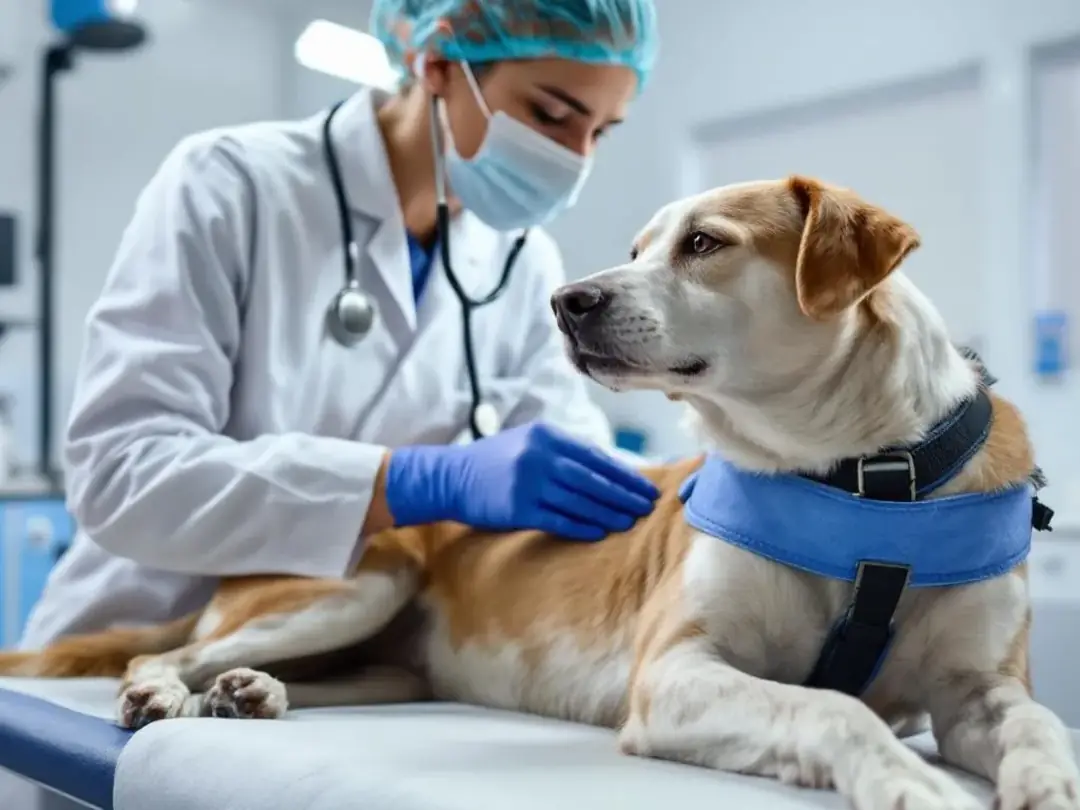Key Takeaways
-
Canine influenza is a highly contagious respiratory disease caused by two influenza A virus strains: H3N8 and H3N2 that can infect dogs of any age or breed
-
Dogs show flu-like symptoms including persistent cough, fever, nasal discharge, and lethargy that typically last two to three weeks with most dogs recovering fully
-
The canine influenza virus spreads rapidly through respiratory droplets and contaminated surfaces, surviving up to 48 hours in the environment and making dog parks and boarding facilities high-risk areas
-
Treatment focuses on supportive care with proper isolation protocols, while canine influenza vaccines are available for dogs at particular risk of exposure
-
Early veterinary diagnosis using nasal or pharyngeal swabs and proper isolation of sick dogs are essential to prevent widespread outbreaks in the dog population
What is Canine Influenza?
Canine influenza, commonly known as dog flu, is a highly contagious respiratory disease caused by specific strains of influenza A virus that have adapted to infect dogs. Dog flu canine influenza is highly contagious and has become prevalent across the United States, making awareness and prompt treatment essential for dog owners. Unlike human flu viruses, canine influenza virus (CIV) represents a distinct pathogen that poses no known risk to humans but can cause significant illness in our canine companions.
Two primary strains of canine influenza virus currently circulate in North America. The H3N8 strain has a fascinating origin story, having jumped from horses to dogs in 2004 when it first appeared among racing greyhounds in Florida. This equine-origin virus had circulated in horses for over forty years before making the species leap that allowed it to infect dogs efficiently. The disease, also referred to as canine flu, emerged after mutating from animal hosts, highlighting the adaptability of influenza viruses.
The H3N2 canine influenza strain follows a different evolutionary path, originating from birds before adapting to dogs. First identified in Asia, particularly in South Korea, this strain made headlines when it caused major outbreaks across the United States beginning in 2015-2016. These widespread H3N2 outbreaks affected thousands of dogs, particularly in urban areas and shelter environments, demonstrating the virus's remarkable ability to spread rapidly through the dog population. Canine influenza is a type of respiratory infection in dogs, causing symptoms such as coughing, nasal discharge, and fever, and requires supportive treatment and preventive measures to control its spread.
Unlike seasonal human influenza, canine influenza can occur throughout the year, making it a constant concern for pet dogs, especially those in high-density environments like boarding facilities, grooming parlors, and dog parks. The virus shows no seasonal pattern, which means infected dogs can transmit the disease to other dogs at any time.
Current surveillance indicates that canine influenza has spread to virtually all parts of the United States, with ongoing scattered outbreaks continuing to affect communities nationwide. This widespread distribution means that veterinary medicine professionals across the country must remain vigilant for signs of canine influenza in their patients.


Clinical Signs and Symptoms
Recognizing the signs of canine influenza requires understanding that this respiratory illness often mimics other common conditions like kennel cough, making professional diagnosis essential. The incubation period typically spans 2-4 days following initial exposure, during which dogs may already be shedding virus to other animals before showing any clinical signs.
Most dogs with canine influenza develop what veterinarians classify as the mild form of the disease. The hallmark symptom is a persistent cough that can be either dry or moist, lasting anywhere from 10 to 21 days. This cough notably fails to respond to conventional antibiotics or cough suppressants, distinguishing it from some bacterial respiratory infections.
Additional symptoms in the mild form include fever above 103°F, nasal discharge that may start clear and become thicker, runny nose, eye discharge, sneezing, reduced appetite, and general lethargy. These respiratory signs typically develop gradually and may initially seem like a simple cold, leading some owners to delay seeking veterinary care.
However, not all dogs experience mild illness. Approximately 20% of infected dogs may develop more severe illness, including high fevers ranging from 104-106°F, significant respiratory distress, and the concerning development of secondary bacterial infections. When dogs develop pneumonia as a complication, the condition becomes potentially life-threatening and requires immediate veterinary hospital intervention.
The H3N2 strain appears more likely to cause severe cases compared to H3N8, with infected dogs showing higher rates of pneumonia and more prolonged illness. Some dogs infected with H3N2 can shed the virus for up to 26 days, significantly longer than the typical 10-day shedding period seen with H3N8.
Certain dogs face increased risk for developing severe illness. A dog's risk of infection and severe disease is influenced by their lifestyle, environment, and health condition, which should be considered when evaluating the need for vaccination. Older dogs and those with underlying heart or respiratory conditions may struggle more with the infection. Brachycephalic breeds like Bulldogs, Pugs, and Boston Terriers are particularly vulnerable due to their already compromised airways, which can make respiratory disease more dangerous.
Interestingly, approximately 20-25% of dogs exposed to canine influenza virus remain asymptomatic despite being infected. These dogs may show no clinical signs whatsoever but can still shed virus and transmit the infection to other dogs, making outbreak control particularly challenging.


How Canine Influenza Spreads
Understanding canine influenza spread is crucial for preventing transmission and protecting both individual pets and the broader dog community. The primary route of transmission occurs through respiratory droplets that infected dogs release when they cough, bark, or sneeze. These microscopic droplets can travel surprising distances, potentially reaching other dogs up to 20 feet away.
Direct contact between dogs facilitates easy transmission, which explains why environments where dogs congregate pose the highest risk. Dog parks, boarding facilities, grooming parlors, dog shows, and shelter environments all provide ideal conditions for the virus to jump from infected dogs to susceptible animals.
However, the virus doesn't require direct dog-to-dog contact to spread. Contaminated objects serve as important vehicles for transmission, with the virus capable of surviving on various surfaces for extended periods. On human hands and skin, the virus remains viable for approximately 12 hours, while clothing can harbor infectious virus for up to 24 hours. Most concerning for facility management, kennel surfaces, food bowls, toys, leashes, and other equipment can maintain infectious virus for up to 48 hours.
This environmental persistence means that careful attention to hygiene becomes essential in preventing canine influenza spread. Handlers, groomers, veterinary staff, and even dog owners can inadvertently carry the virus on their clothing or hands from one dog to another, making proper sanitation protocols critical.
The virus demonstrates remarkable efficiency in spreading through dog populations. Nearly 100% of dogs exposed to canine influenza virus become infected, though the severity of illness varies dramatically. This high attack rate means that even brief exposure in high-risk environments can result in infection.
Timing of contagiousness adds another layer of complexity to outbreak control. Dogs typically reach peak contagiousness during the incubation period, before owners recognize that their pet is ill. This means that dogs may be actively shedding virus and infecting other animals while appearing completely healthy, making it nearly impossible to identify and isolate infectious dogs before transmission occurs. Because of this challenge, isolating dogs-both those showing symptoms and asymptomatic carriers-is a critical step in outbreak control, with quarantine periods recommended to help prevent further spread.
The contagious period varies by strain, with H3N8-infected dogs typically shedding virus for up to 10 days post-exposure, while H3N2 can result in viral shedding for up to 26 days. During this entire period, infected dogs pose a transmission risk to other pets they encounter.


Diagnosis of Canine Influenza
Obtaining an accurate diagnosis when canine influenza is suspected requires professional veterinary evaluation, as the clinical signs closely resemble those of kennel cough and other components of infectious respiratory disease complex. Pet owners should never attempt to diagnose or treat suspected canine influenza at home, as proper identification and management require specialized testing and expertise.
The gold standard for diagnosing acute canine influenza infection involves polymerase chain reaction (PCR) testing performed on samples collected from the respiratory tract. Veterinarians typically obtain these samples using nasal swab or pharyngeal swabs, though conjunctival swabs may also be collected. For optimal accuracy, sample collection should occur within the first few days of symptom onset, when viral loads remain highest.
PCR testing offers the advantage of rapid results and high specificity, allowing veterinarians to definitively identify whether a dog is infected with canine influenza and which strain is causing the illness. This information proves valuable for treatment planning and outbreak control measures.
When the acute phase has passed and PCR testing may no longer detect virus, serology testing becomes the preferred diagnostic approach. This method measures CIV antibodies in the blood, requiring paired samples collected 2-3 weeks apart to demonstrate rising antibody levels that confirm recent infection. While serology cannot provide immediate answers, it offers valuable information for confirming past infection and assessing immunity status.
Additional diagnostic tools may be employed when dogs develop complications. Chest X-rays help veterinarians assess whether dogs have developed pneumonia, while blood work can evaluate overall health status and guide treatment decisions. In severe cases, bacterial culture of respiratory secretions may be performed to identify secondary bacterial infection and guide antibiotic selection.
Given the highly contagious nature of canine influenza, veterinary hospitals have developed special protocols for managing suspected cases. Many practices request that owners call ahead when bringing in a dog suspected of having respiratory illness, allowing staff to minimize exposure to other patients. Some facilities provide separate entrances or isolation areas specifically for dogs with respiratory disease.
The importance of professional diagnosis cannot be overstated, as canine influenza diagnosed early allows for appropriate isolation measures that can prevent wider community spread. Additionally, confirming the diagnosis helps veterinarians provide appropriate supportive care and monitor for complications that might require more intensive treatment.


Treatment and Management
Treatment for canine influenza focuses on supportive care, as no specific antiviral medications are routinely used in veterinary medicine for this condition. The approach is largely supportive, emphasizing rest, proper hydration, and maintaining the dog comfortable while their immune system fights the infection. Most dogs recover completely with appropriate care, though the process requires patience and careful monitoring.
For dogs with mild symptoms, home care may be sufficient under veterinary guidance. Creating a warm, dry environment helps infected dogs rest comfortably, while humidifiers or steam from hot showers can ease respiratory discomfort. Ensuring adequate hydration remains crucial, as fever and reduced appetite can quickly lead to dehydration.
However, dogs showing signs of severe illness require hospitalization and intensive supportive care. Veterinary hospitals can provide intravenous fluids to maintain hydration and electrolyte balance, oxygen therapy for dogs with respiratory distress, and careful monitoring for complications. Some dogs may benefit from nutritional support if their reduced appetite persists for several days.
When dogs develop secondary bacterial infections, particularly pneumonia, antibiotic therapy becomes necessary. Veterinarians select antibiotics based on the most likely bacterial pathogens and may adjust treatment based on culture results when available. Common choices include broad-spectrum antibiotics effective against respiratory bacteria.
Pain management may be appropriate for some dogs, particularly those with severe coughing or general discomfort. Nonsteroidal anti inflammatory medications can help reduce fever and improve comfort, though these must be used carefully and only under veterinary supervision.
Isolation protocols form a critical component of management, both for the individual dog's recovery and community health protection. Infected dogs should be isolated from other dogs for at least 3-4 weeks, or until they have been fever-free and symptom-free for at least one week. This isolation period helps prevent transmission to other pets and allows the infected dog to recover without stress from social interactions.
During the isolation period, dogs should avoid all contact with other dogs, including walks in public areas, visits to dog parks, grooming appointments, and boarding. Even seemingly innocent encounters with neighborhood dogs during walks can result in transmission, making strict isolation essential.
Most dogs recover within two to three weeks when provided with appropriate care. However, dogs that develop pneumonia or other complications may require longer recovery periods and more intensive treatment. Throughout the recovery process, maintaining close communication with the veterinary team ensures that any changes in condition receive prompt attention.
The recovery timeline can vary significantly between individual dogs and between strains. H3N2 infections often result in longer illness duration compared to H3N8, and some dogs may experience lingering cough or fatigue for several weeks beyond the acute illness phase.
Prevention Strategies
Preventing canine influenza requires a multi-faceted approach combining vaccination, environmental management, and good hygiene practices. For dogs at particular risk, vaccination represents the most effective prevention strategy, though it requires advance planning to provide optimal protection.
Canine influenza vaccines are available for both major strains, with many veterinarians recommending bivalent vaccines that protect against both H3N8 and H3N2. The CIV vaccine can be administered to puppies as young as 7-8 weeks of age, with an initial series requiring two doses given 3-4 weeks apart. Annual boosters maintain immunity and ensure continued protection against both strains.
Vaccination decisions should be based on the dog's risk of exposure rather than treating it as a routine vaccine for all dogs. Dogs that frequently visit dog parks, attend dog shows, travel frequently, or stay in boarding facilities face higher exposure risk and typically benefit from vaccination. Similarly, dogs in areas experiencing active outbreaks should receive priority for vaccination.
While vaccination significantly reduces the severity and duration of illness, it does not provide complete immunity. Vaccinated dogs may still become infected but typically experience milder symptoms and shed virus for shorter periods, reducing transmission risk to other animals.
Environmental prevention strategies focus on avoiding high-risk situations, particularly during known outbreaks. When canine influenza activity increases in a community, temporarily avoiding dog parks, group training classes, and other gatherings can protect susceptible dogs. For facilities like boarding kennels and grooming parlors, implementing enhanced screening procedures helps identify potentially infected animals before they enter the facility.
Hygiene practices provide an additional layer of protection, particularly for people who interact with multiple dogs. Thorough hand washing after contact with any dog, especially those showing respiratory signs, prevents inadvertent virus transmission. People working in veterinary hospitals, grooming facilities, or animal shelters should change clothing between handling different animals when possible.
Effective disinfection helps eliminate virus from contaminated surfaces. Standard household disinfectants, including dilute bleach solutions, effectively destroy influenza viruses on surfaces. Regular cleaning and disinfection of shared equipment like food bowls, toys, and grooming tools reduces environmental contamination.
For individual dog owners, maintaining their pet's overall health supports immune function and may help reduce susceptibility to severe illness. Ensuring dogs receive appropriate nutrition, regular exercise, and routine preventive care creates the best foundation for disease resistance.
Public Health Concerns
While the canine influenza virus does not pose a direct threat to human health, it remains a significant concern for the canine community and those who care for dogs. There is no evidence that the influenza virus responsible for dog flu can infect humans, but the rapid spread among dogs means that outbreaks can have a substantial impact on pet populations, animal shelters, and veterinary practices.
Public health organizations, including the Centers for Disease Control and Prevention (CDC), closely monitor canine influenza outbreaks to ensure that any potential risks are quickly identified and managed. Their surveillance helps track the spread of the virus and supports efforts to contain outbreaks, especially in areas with dense dog populations.
One of the most important public health considerations is the risk of secondary bacterial infections in infected dogs. While most dogs experience only mild signs of canine influenza, such as coughing, sneezing, and a runny nose, some may develop more severe illness if bacteria take advantage of the weakened respiratory tract. These secondary bacterial infections can lead to pneumonia and may require hospitalization and aggressive treatment to ensure a full recovery.
Dog owners and handlers should remain vigilant for the signs of canine influenza, including persistent cough, nasal discharge, and lethargy. Early recognition and prompt veterinary care are essential to prevent complications and reduce the risk of severe illness. By taking precautions-such as isolating sick dogs, practicing good hygiene, and seeking veterinary attention when symptoms appear-owners can help protect both their pets and the broader dog community from the effects of this highly contagious respiratory disease.
Recovery and Outlook
The outlook for most dogs infected with canine influenza is positive, with the majority recovering fully within two to three weeks when provided with appropriate supportive care. During this period, dogs may experience symptoms such as coughing, nasal discharge, and reduced appetite, but these typically resolve as the immune system clears the infection.
However, some dogs-particularly those with pre-existing health conditions, compromised immune systems, or very young or old age-may be at risk for more severe illness. In these cases, secondary bacterial infections can develop, leading to complications like pneumonia. Prompt veterinary intervention is crucial for these dogs, as early treatment with antibiotics, fluids, and nonsteroidal anti inflammatory medications can significantly improve outcomes and reduce the risk of long-term health issues.
Supportive care remains the cornerstone of treatment for all infected dogs. This includes ensuring the dog is comfortable, well-hydrated, and receives any prescribed medications. Owners should carefully follow their veterinarian's recommendations and monitor for any changes in their dog's condition, especially signs of worsening respiratory distress or persistent fever.
To prevent the spread of canine influenza to other dogs, it is essential to keep infected dogs isolated from other dogs and avoid sharing toys, bedding, or food bowls that could act as contaminated objects. Maintaining strict hygiene and minimizing contact with other pets during the recovery period helps protect the wider dog population from this infectious respiratory disease.
With attentive care and proper management, most dogs recover from canine influenza without lasting effects, returning to their normal activities once they are symptom-free and cleared by their veterinarian.
Special Considerations
Several unique aspects of canine influenza require special attention from dog owners and veterinary professionals. Unlike many other canine diseases, canine influenza virus CIV occasionally demonstrates the ability to cross species barriers, with documented cases of H3N2 transmission to cats, particularly in shelter environments where close contact and stress may facilitate transmission.
Shelter cats housed near infected dogs have developed respiratory illness consistent with influenza infection, though cats appear less susceptible than dogs and typically experience milder symptoms. This cross-species potential highlights the importance of proper isolation protocols in facilities housing multiple species.
Fortunately, extensive surveillance and research have found no evidence that canine influenza virus can transmit from dogs to humans. This provides reassurance to dog owners and veterinary professionals who may be concerned about zoonotic transmission. However, people can serve as mechanical carriers, transporting virus on clothing or hands between dogs.
Mortality rates from canine influenza remain relatively low when dogs receive appropriate care. H3N8 typically results in mortality rates of 1-5%, while overall mortality rates across both strains generally remain under 10%. However, these statistics improve dramatically when dogs receive prompt veterinary attention and appropriate supportive care.
The impact of canine influenza extends beyond individual pets to affect entire communities and industries. During major outbreaks, animal shelters may temporarily close to new admissions, boarding facilities may restrict services, and dog shows or training events may be canceled. These economic and social impacts underscore the importance of prevention and rapid outbreak response.
Some states have recognized canine influenza as a reportable disease, requiring veterinarians to notify public health authorities when cases are diagnosed. This surveillance helps track disease spread and coordinate community response efforts.
The potential for new strains to emerge through viral mutation remains a ongoing concern in veterinary medicine. The historical pattern of influenza viruses jumping between species, as seen with both H3N8 and H3N2, suggests that continued surveillance and research remain essential for protecting animal and public health.
FAQ
Can my dog catch human flu or can I catch dog flu from my pet?
No, there is no evidence that dogs can contract human flu viruses, and canine influenza virus cannot transmit from dogs to humans. These are completely different strains of influenza virus that have adapted to specific species. However, humans can carry canine influenza virus on their hands or clothing and accidentally transmit it between dogs.
How long should I keep my dog isolated if they have canine influenza?
Dogs with canine influenza should be isolated from other dogs for 3-4 weeks total, or until they have been completely free of fever and respiratory symptoms for at least one week. During this time, avoid all contact with other dogs, including walks in public areas, dog parks, grooming, and boarding. This isolation period prevents transmission and allows full recovery.
Is the canine influenza vaccine necessary for all dogs?
The canine influenza vaccine is not considered a core vaccine for all dogs. Vaccination decisions should be based on your dog's risk of exposure. Dogs that frequently visit dog parks, stay in boarding facilities, attend dog shows, or live in areas with active outbreaks benefit most from vaccination. Indoor dogs with minimal exposure to other dogs typically don't require routine vaccination.
What's the difference between kennel cough and canine influenza?
While both cause respiratory symptoms, canine influenza typically lasts longer (10-21 days) compared to kennel cough and more commonly causes fever and secondary bacterial infections. Kennel cough is often caused by Bordetella bacteria and may resolve more quickly with appropriate treatment. Professional diagnosis is essential since the symptoms overlap significantly.
Can outdoor cats get canine influenza from infected dogs?
Yes, the H3N2 strain of canine influenza can occasionally infect cats, particularly in shelter environments where cats and dogs are housed near each other. However, cats appear less susceptible than dogs and typically experience milder symptoms. Outdoor cats with limited exposure to infected dogs face relatively low risk, but those in multi-pet households should be monitored if dogs develop respiratory illness.






